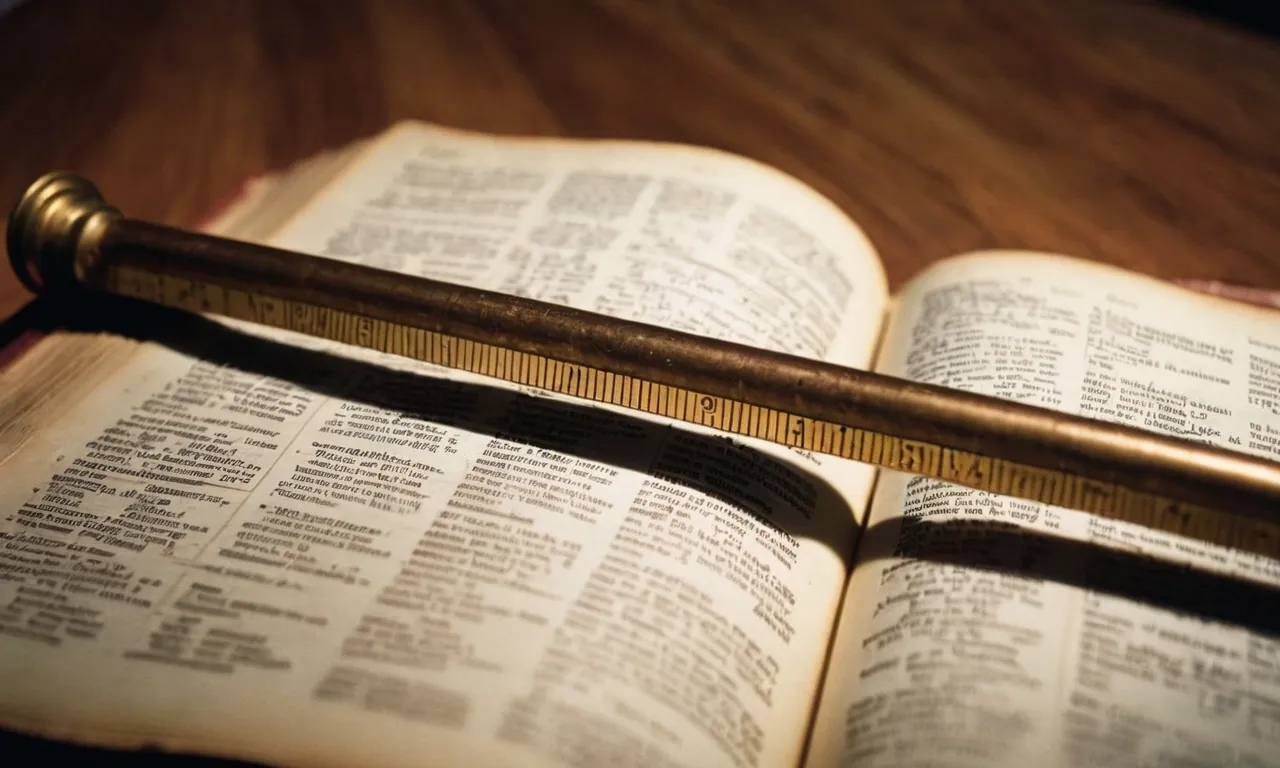How Long Is A Stadia In The Bible?
If you’ve ever read through the Bible and come across obscure units of measurement like stadia, you may have wondered exactly how long a stadia is. This ancient unit of length is mentioned numerous times in the Bible, especially in the New Testament. So what exactly is a stadia and how long is it?
If you’re short on time, here’s a quick answer to your question: A stadia is an ancient Greek unit of length equivalent to about 607 feet or 185 meters.
In this comprehensive guide, we’ll dive into the fascinating history of the stadia, examine all the biblical references to this unit, look at how it was used in the ancient world, and provide a precise conversion to modern measurements.
The Origins and History of the Stadia
Introducing the Stadia – An Ancient Greek Unit
The stadia (singular: stadium) was an ancient Greek unit of length that was most commonly used to measure distance. Its origins can be traced back to 600 BCE when it was originally defined as the length of a typical sports stadium racetrack for that time, which was about 190 meters or 625 Roman feet.
The stadia gained widespread popularity throughout ancient Greece as Greeks excelled in sports and athletic competitions. Over the years, there emerged slightly different definitions of the stadia based on the region. But most ranged from 177 meters (Athens) to 215 meters (Olympia).
The Stadia in the Greek World
The stadia unit was widely adopted across major Greek cities and regions for measuring distances. Some key uses:
- In Athens, 1 stadia = ~177m
- In Greek Ptolemaic Egypt, 1 stadia = ~157.5m
- In ancient Olympia, 1 stadia = ~192m (length of the stadium where the Olympic Games were held)
The stadia even became closely tied to Greek geography and maps. The historian Eratosthenes in 240 BCE used the stadia for determining key measurements in his famous world map.
Use of the Stadia in the Roman Empire
The stadia measurement was further popularized when the Romans conquered Greek territories in 2nd century BCE. The Romans widely applied it for measuring distances on roads, plotting lands, establishing building foundations etc. But the most common standard they used was 1 Roman stadia = 185 meters.
| 1 stadia (Greek Egyptian) | = 157.5 meters |
| 1 stadia (Roman) | = 185 meters |
Biblical References to the Stadia
Old Testament References
The stadia, a unit of length measurement, is referenced several times in the Old Testament. In 2 Chronicles 4, the dimensions of the Bronze Sea in Solomon’s temple are given in cubits, with the diameter measuring 10 cubits and the circumference measuring 30 cubits, which would equate to about 15-16 stadia.
In the Book of Ezekiel, dimensions of areas of the temple are given in reeds and stadia (Ezekiel 40-48). For example, the outer court of the temple is described as having a length of 100 cubits and a width of 50 cubits, which would equal about 6-7 stadia in length and 3-4 stadia in width (Ezekiel 40:19, 47).
New Testament References
There are a few references to stadia in the New Testament as well. When Jesus miraculously fed the five thousand, he first told his disciples to have the people sit down in groups on the green grass, and Mark notes there was much grass in the place, about five thousand men gathered there (Mark 6:39-44).
This large grassy area could have covered the size of several stadia.
After Jesus’ ascension, Luke records the return of the disciples to Jerusalem from the Mount of Olives as being a “Sabbath day’s journey away” (Acts 1:12), which was about 5 or 6 stadia. So there are small hints at the stadia unit of measurement being useful even in New Testament times.
Significance of the Stadia in Scripture
The stadia measurement may seem obscure today, but it was commonly used in Old Testament times to measure out the dimensions of important structures like Solomon’s temple and Ezekiel’s prophetic vision for a new temple.
The stadia gave a concept of the size and scale of these large courtyards and sacred spaces. It also shows God’s specific plan for how he wanted his dwelling place designed among his chosen people.
A day’s journey or Sabbath day’s journey was also a common travel reference in biblical times. So even though not directly emphasized or explained, the stadia as a unit connects to key narratives and aspects of life during the biblical era.
The Length of a Stadia
Variation in Ancient Stadia
In ancient Greece, the length of a stadia varied depending on the region and era. The most common stadia was the Athenian stadia which measured 600 ancient feet or about 185 meters. However, other city-states used stadia of different lengths.
For example, the Olympian stadia measured 600 Greek feet or about 192 meters. There was also an Egyptian stadia measuring 157.5 meters. Most ancient stadia ranged between 150 to 200 meters.
Modern Conversion of the Olympian Stadia
Since the olympic games originated in Olympia, the olympian stadia became the most widely used unit. Modern scholars have calculated its exact length as 192.27 meters by studying the remains of ancient Olympia. This is equivalent to 630.03 modern feet. Some key conversions are:
- 1 ancient olympic stadia = 192.27 meters
- 1 stadia = 630.03 modern feet
- 1 kilometer = 5.03 ancient stadia
Comparable Modern Distances
To understand how far a stadia is, some comparable modern athletic distances are:
| Ancient Stadia | Modern Equivalent |
| 1 Stadia | 200 meter track length |
| 2 Stadia | Ancient olympic stadium length |
| 10 Stadia | Men’s 10,000 meter race |
| 20 Stadia | Olympic marathon distance |
So a stadia represents a common racing length even today. The olympic stadium and races like the marathon are direct descendants of ancient greek measurements in stadia.Knowing stadia lengths thus provides insight into the worlds of ancient athletics and distances mentioned in biblical texts.
The Stadia in Context
Use in Travel and Navigation
The stadia was an important unit of distance in the ancient world, especially for travelers and navigators. One stadia was equivalent to about 607 feet or 185 meters, so it represented the length that a person could walk in the stadium.
This made it a useful reference point for journeying on foot or horseback. Ancient sources like Herodotus mentioned distances between cities in stadia. The stadia gave travelers a sense of how far they needed to go and allowed them to estimate travel times.
It served a similar function to how we use miles or kilometers today.
The stadia was also useful for early cartographers trying to map distances. Ancient geographers like Eratosthenes calculated the circumference of the Earth using the stadia as a base unit. While the lengths were not perfectly accurate, they allowed the ancient Greeks and Romans to conceptualize geography and create some of the first maps of the known world.
So the stadia played an important role in the growth of navigation, travel, and our understanding of distances.
Role in Sports and Athletics
The stadia was the actual length of the stadium racetrack in ancient Greece. The original Olympics used a stadia of about 600 feet for foot races. The stadia became the standard unit to record distances in Greek sporting events like running, chariot racing, and javelin throwing.
Sports scholars today still use the stadia as a way to compare ancient athletic achievements.
The stadia also represented something symbolic in Greek sports – it was the length of the ultimate athletic feat. Champions were written about as those who “ran the stadia” in a certain time. Running the full stadium length without stopping was seen as an impressive demonstration of speed and endurance.
So while a practical unit, the stadia took on a legendary status for sporting prowess. This adds to why it became so embedded in ancient Greek culture.
Appearances in Everyday Life
Beyond travel and sports, the stadia worked its way into Greek and Roman daily life. Houses and farms were measured out in numbers of stadia for deeds. The dimensions of buildings like temples were often multiples of the basic stadia.
Having standard stadia measurements allowed craftsmen to plan projects and estimate costs. Even larger distances were often referred to “in stadia” rather than converted to miles. And since Roman soldiers regularly ran and marched defined stadia distances as part of military training, the unit influenced army logistics as well.
| Measurement System | Ancient Greece/Rome | Modern World |
| Basic unit of distance | Stadia (~607 ft) | Meter (~3 ft) |
| Long distances | Multiples of stadia | Kilometers/miles |
| Derived units | Plethenon (100 stadia) Mile (8 stadia) |
Centimeters, feet, etc. |
So while not as ubiquitous as the modern meter, the stadia was woven into the fabric of Mediterranean society. It represented an important step in humanity’s ability to standardize distance. The stadia’s role and legacy is a testament to how useful it was in the ancient world.
Conclusion
The stadia has a long and fascinating history stretching back to ancient Greece. Though not frequently used today, this unit gave critical distance measurements in both Scripture and the ancient world.
After examining the biblical references and ancient evidence, we can conclude that the standard Olympian stadia equaled about 607 feet or 185 meters.
The stadia provides modern readers a window into the cultures of biblical times. By understanding obsolete units like the stadia, we can better grasp the world in which the biblical events unfolded. The stadia’s role in travel, sports, and daily life illuminates many passages of Scripture for the careful reader.








